HNL 1950s
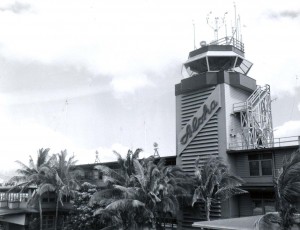 By 1950, the boundaries of Honolulu Airport, including the Seadrome channels, comprised an area of 1,019.476 acres. However, title to an area of 177.883 acres within the airport and adjoining Hickam Air Force Base, on which the ends of runway 14-32 and 8-26 encroached, rested with the Air Force. An effort was made to acquire this land from the Air Force to meet CAA requirements in the expenditure of federal funds for improvements to the runway and to tie runway 8-26 into the Hickam extension of this runway.
By 1950, the boundaries of Honolulu Airport, including the Seadrome channels, comprised an area of 1,019.476 acres. However, title to an area of 177.883 acres within the airport and adjoining Hickam Air Force Base, on which the ends of runway 14-32 and 8-26 encroached, rested with the Air Force. An effort was made to acquire this land from the Air Force to meet CAA requirements in the expenditure of federal funds for improvements to the runway and to tie runway 8-26 into the Hickam extension of this runway.
Overseas operations doubled at Honolulu Airport in 1951 due to the Korean Airlift operation and the insignia of large transport aircraft bearing such names as Sabena (Belgian), American Overseas, Eastern Airlines, Western Airlines, California Central Airlines, California Eastern Airlines, Flying Tigers, Overseas National Airlines and Seaboard Western Airlines, United Airlines, American Airlines and Pan American World Airways were seen at the airport.
The thousands of service men of the United Nations stopping over at the terminal enroute to Korea and returning as casualties, as well as the evacuation of military dependents from Japan, made Honolulu Airport unique in the war effort.
While all civilian aircraft involved in the airlift were serviced at Honolulu Airport, aircraft of the Military Air Transport Service landed at Honolulu Airport and taxied to Hickam AFB. These operations, together with the regular overseas and interisland carriers, placed Honolulu Airport in third place for the entire nation in total control tower operations.
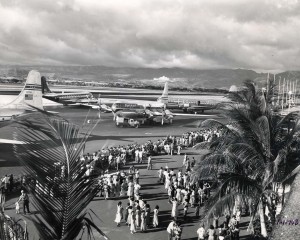 The heavy increase in traffic and new demands on the terminal necessitated the commencement of plans for major alterations at the terminal. The federal government would not sanction the construction of a new terminal prior to July 1, 1954, because of the war emergency program.
The heavy increase in traffic and new demands on the terminal necessitated the commencement of plans for major alterations at the terminal. The federal government would not sanction the construction of a new terminal prior to July 1, 1954, because of the war emergency program.
In November 1950, Pan American World Airways observed the 15th anniversary of its first trans-Pacific flight from San Francisco to Honolulu, Midway, Wake, Guam and Manila. The first flight was made by the China Clipper which carried the first air mail from San Francisco to Manila. During the 15 years since its first trans-Pacific flight, Pan Am made 18,254 flights between the Mainland U.S. and Hawaii, and carried a total of 281,613 passengers.
On December 4, 1950 a Pan American Strato Clipper set a new commercial air record for a flight between Honolulu and Los Angeles by making the trip in 7 hours and 20 minutes.
An area of about 104 acres of the Hickam Field reservation was formally leased by the Hawaii Aeronautics Commission On February 7, 1951 for 20 years. This lease enabled the Commission to pave a 540-foot connecting link with the new Hickam extension to Runway 8-26, making a runway 200 feet wide and 13,104 feet long. Runway 8-26 was one of the world’s longest runways. Honolulu Airport was the third busiest airport in the U.S. at this time.
Act 3, Session Laws of Hawaii 1951, was signed by the Governor on April 27, 1951 to change the name of Honolulu Airport to Honolulu International Airport. The Act took effect 10 days after its promulgation.
The first Honolulu International Airport Master Plan by Clark M. Kee, Consulting Engineer for HAC, was distributed in April 1951.
Hickam Air Force Base completed its section of 5,417 feet of runway joining with 7,650 feet of HNL runway to form a continuous runway of 13,067 feet for instrument Runway 8-26 in May 1951.
Architects were making good progress in the designing of a new Overseas Terminal for Honolulu International Airport, the interisland section of which could be under construction by late 1952 or early 1953. When finally completed, the entire terminal facility for the international airport, including the new Overseas Terminal, International Arrivals Building, restaurant, parking areas, ramps, facilities for air express, provision for future seaplane operation, etc., was estimated to cost $5 million.
Recognizing the importance of making visitors welcome in Hawaii, the HAC completed construction of new Lei Stands near the main entrance of the airport on Lagoon Drive . The construction was completed in June 1952 at a cost of $31,710. The Lei Stands replaced cars and trucks which previously had parked on the airport entry road. Their owners sold leis they had made from the back of their vehicles to arriving and departing passengers.
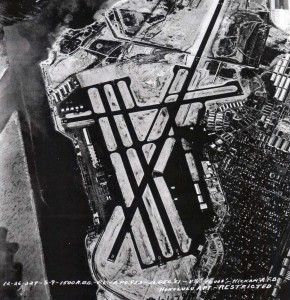 Honolulu International Airport’s 13,097 foot runway was officially declared the longest runway in the world by the Airport Operators Council on April 14, 1953.
Honolulu International Airport’s 13,097 foot runway was officially declared the longest runway in the world by the Airport Operators Council on April 14, 1953.
Progress on the planning of a new terminal for Honolulu was stalled due to a land utilization problem. Terminal facilities proposed by the HAC encroached upon land under the jurisdiction of the U.S. Navy. Negotiations with Navy officials seeking adjustments which would permit a continuation of construction plans as designed failed. Entirely new plans for the terminal and other terminal areas facilities were begun.
Honolulu International Airport accommodated 255,385 aircraft operations in 1953 as compared to 194,129 the previous year. Contributing heavily to the increase was the movement of military aircraft. On a national scale, Honolulu Airport handled the largest number of military aircraft movements of any civilian facility.
Preliminary plans for a new passenger terminal at Honolulu International Airport were approved by the Hawaii Aeronautics Commission in March 1954. Immediately following approval of the preliminary plans, authorization was granted to proceed with construction plans and specifications. According to the timetable set by the Superintendent of Public Works, actual construction was to start on this project not later than mid-1955.
In 1954, the HAC adopted a Resolution requesting the assistance of the Airport Use Panel in reviewing problems surrounding the development of facilities and joint military use of Honolulu International Airport. Subsequently, however, the HAC in cooperation with the military held up work on new terminal facilities and the Master Plan for Honolulu International Airport pending completion of a joint master plan of the composite area comprised of Honolulu International Airport, Hickam Air Force Base and Keehi Lagoon. This action deferred the filing of the Resolution with the Airport Use Panel by the Commission.
United Air Lines inaugurated the first DC-7 passenger service to Hawaii. The new service replaced United’s Boeing Stratocruiser flights and reduced flight time between California and Hawaii by more than one hour.
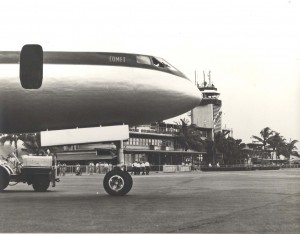 On December 13, 1955 Honolulu International Airport became the first civilian airport in the nation to get a preview of commercial jet aircraft operation when the British DeHavilland Comet III jet-liner arrived on a good will flight around the world. The jet aircraft remained in Honolulu for two days and gave a series of courtesy flights to ranking government officials, aviation officials and tourists. The Comet made the flight from Honolulu to Vancouver, British Columbia, in five hours and 39 minutes, a distance of 2,738 statute miles.
On December 13, 1955 Honolulu International Airport became the first civilian airport in the nation to get a preview of commercial jet aircraft operation when the British DeHavilland Comet III jet-liner arrived on a good will flight around the world. The jet aircraft remained in Honolulu for two days and gave a series of courtesy flights to ranking government officials, aviation officials and tourists. The Comet made the flight from Honolulu to Vancouver, British Columbia, in five hours and 39 minutes, a distance of 2,738 statute miles.
The announcement by most major airlines serving Hawaii of their decision to purchase jet aircraft and have them in operation between Hawaii and the Mainland by the middle of 1959 necessitated the expansion and improvement of the airport to handle this additional modern traffic.
The HAC had enough funds to undertake a major portion of the expansion and the construction of a new Terminal Building. With the addition of federal participating funds, this proposed expansion was set forth in the new master plan as approved by the HAC.
The expansion of the airport also necessitated the exchange of land between the Territory and the federal government, plus acquisition of portions of the Damon Tract area adjacent to the airport. The land exchange program was necessary to acquire land now under the direct jurisdiction of the Navy, the Air Force, and the Army for the construction of the new Terminal buildings and the service areas, also the relocation of runways, taxiways, and aprons.
The expansion of the airport and the construction of the new terminal area was timed to the schedules of the major airlines starting their jet operation in late 1959 or early 1960.
In 1956 work continued on the Master Terminal Site Plan for Honolulu International Airport embodying development of a jet age airport and a modern passenger terminal building. The HAC held several meetings with the Air Lines Technical Committee representing airlines serving Hawaii, the Department of Public Works, the Civil Aeronautics Administration, and other users to develop the plan which was approved in September 1956.
The outstanding feature of the terminal site plan was the proposed passenger terminal building which would be constructed on the north side of the field near the area then occupied by Hawaiian Airlines, Ltd.
Designed by architect Theodore A. Vierra, the new terminal would be made up of four separate units. The main unit consisted of the overseas departure section and an administration building. The Administration Building would provide office spaces for the Commission, the CAA, Weather Bureau, various overseas airlines, and other users.
The Airport Control Tower was located on the two top floors. The ground floor areas were for the overseas departure section. The restaurant and the public lobby were also located in this section. The other three units were a domestic overseas arrival section, a foreign arrival section, and an interisland section.
The terminal site plan provided space for other facilities, such as cargo and freight buildings, aircraft servicing and maintenance areas, aeronautical school, automobile service station, auto parking area for 4,200 cars, lei stands, and a heliport.
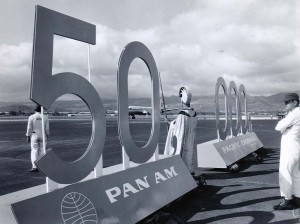 The development of the new terminal site was financed through Airport Revenue Bonds, Territorial General Obligation Bonds, and federal funds.
The development of the new terminal site was financed through Airport Revenue Bonds, Territorial General Obligation Bonds, and federal funds.
The HAC contracted the services of Lockheed Air Terminal, Inc. for a study on the financial structure of the airport, and to recommend changes in rates and charges for the use of airport facilities so that future revenues would be adequate for the refunding of the obligations incurred in the construction and development of the new airport.
The Territorial Legislature enacted three joint resolutions to implement the development and expansion of Honolulu Airport. These resolutions went before Congress and when enacted would authorize certain land exchanges between the Territory, the U.S. Navy and the U.S. Air Force for the development of the Honolulu International Airport complex (comprised of the Master Plan development of Honolulu International Airport by the Territory, Hickam Air Force Base by the U .S. Air Force and Keehi Lagoon by the U.S. Navy), the issuance of $14 million aviation revenue bonds by the Commission and would allow the HAC to lease land for a maximum period of 65 years.
In 1956 an agreement was reached with the military services and called for mutual transfer of real estate. It was signed by the Army, Navy, Air Force, Territory of Hawaii and the CAA. It set up the only major joint-use airport in the United States with Hickam, HNAS, Fort Kamehameha and Honolulu International Airport to be used as a single airport complex. The Hawaii Aeronautics Commission approved a new Master Terminal Site Plan for HNL in September 1956. Land for new jet terminal was acquired in 1958 at a cost of $5 million.
The Federal Government granted a 25 year lease for 248 acres while the Territory granted 25 year leases on 172 acres of land and 344 acres of submerged land for Naval aviation purposes. Sixty-seven acres of land was also acquired from the Damon Tract by eminent domain.
Preliminary work for the site preparation of the proposed terminal building was undertaken with the stockpiling of coral to be used for fill.
For the first time, Honolulu International Airport was ranked with those on the mainland United States by the CAA in its Federal Airways Air Traffic Activity report for 1956 and placed 18th in this category. At the end of the FY, Honolulu was in 14th place.
In 1957, the Territory was awarded possession of 67.288 acres of Damon Tract land required by the HAC for the site of the proposed terminal building and allied facilities at Honolulu International Airport. The land parcel, located on the north side of the airport, was condemned by the Commission through eminent domain proceedings and the amount paid for just compensation was determined by a jury trial in the Circuit Court. The Commission deposited $3,586,000 with the clerk of the court as fair valuation for the land.
Earlier, the Territory and the federal government exchanged land parcels whereby the Territory was granted 25-year leases for 248 acres required for the master plan development of the jet-age airport. In return, the Territory granted 25-year leases on 172 acres of land and 344 acres of submerged land to the federal government for Naval aviation purposes.
In preparation for the construction of the proposed Terminal Building, allied facilities and master plan development of Honolulu International Airport, the Commission engaged the services of Eastman Dillon Union Securities and Co. to handle the marketing of the $14 million in aviation revenue bond issue, authorized by Joint Resolution 32, Session Laws of Hawaii 1957. Before the Commission could proceed with the sale of the bonds, Congressional authorization was required to exclude the bonds from the limitation imposed by the Organic Act upon the general obligation bond indebtedness of the Territory. This was accomplished by Congressional bill P.L. 85-534 authorizing the issuance of aviation revenue bonds, the land exchange and leasing of land to air carriers for 55 years. P.L. 85-534 was signed by the President on July 18, 1958.
The HAC hired Quinton Engineers to conduct an engineering feasibility study to determine the adequacy of the specifications of the proposed Terminal Building, allied facilities and the over-all airport development project to accomplish the intended purpose and to analyze the cost estimates for the master plan development of the airport.
The HAC hired Quinton Engineers to conduct an engineering feasibility study to determine the adequacy of the specifications of the proposed Terminal Building, allied facilities and the over-all airport development project to accomplish the intended purpose and to analyze the cost estimates for the master plan development of the airport.
An economic feasibility study to determine the adequacy of estimated net revenue from the Aviation Fuel Tax and the operation of the Territorial airport system to repay the proposed bond issue was conducted for the HAC by Coverdale and Colpitts, consulting engineers.
The engineering and economic feasibility studies were requested by Eastman Dillon Union Securities and Co. and the reports were used in connection with the sale of the aviation revenue bonds.
Lockheed Air Terminal, Inc. airport consultant, prepared a scheduled of rates and charges to be applied to the new Terminal facilities in 1958. The Commission adopted the proposed schedule and copies of the rates and charges were sent to all air carriers and tenants so that they could get an idea of what they would be charged for the use of the new terminal facilities.
Construction of the jet-age facilities for Honolulu International Airport was started by the HAC on February 11, 1959. Work progressed on the Site Preparation Stage 1 of the project for $1,079,150.
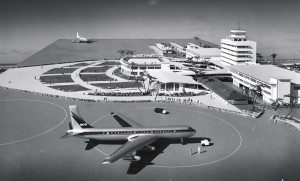 On February 5, 1959, a groundbreaking ceremony was held to mark construction of this long-awaited construction project which would implement the Master Plan development of this airport. Following the blessing of the ground by the Reverend Abraham K. Akaka, pastor of Kawaiahao Church, a small charge of dynamite was set off by William F. Quinn, Governor of Hawaii, to blast Honolulu into the commercial jet age.
On February 5, 1959, a groundbreaking ceremony was held to mark construction of this long-awaited construction project which would implement the Master Plan development of this airport. Following the blessing of the ground by the Reverend Abraham K. Akaka, pastor of Kawaiahao Church, a small charge of dynamite was set off by William F. Quinn, Governor of Hawaii, to blast Honolulu into the commercial jet age.
Governor Quinn stated that this new “jet age facility is the first of our major public improvements when Hawaii becomes a state” and “a facility which Hawaii will be proud of.”
Voicing the sentiment of the people of Hawaii, Dr. Francis K. Sylva, chairman of the HAC, declared, “This is the day we have been waiting for, for a long, long time.” He added that the delay until now in starting construction was a “blessing in disguise” in that the Commission “has been able to avoid making mistakes of other airports. . . The new terminal facilities will be the first in the nation to be built for the commercial jet-age from the ground up.”
Land required for the site of the new terminal facilities on the north side of the airport was acquired by condemnation of 67.288 acres of Damon Tract land. Eminent domain proceedings in this condemnation suit were settled by an out-of-court compromise by the Attorney General’s Office. Price paid for the land was $4,950,000, exclusive of appraisal, legal, court fees, and other costs. Deed to this land was received by the Commission in October 1958.
Construction of the jet-age facilities was financed by the proceeds from the sale of $15 million Aviation Revenue Bonds and a $2,875,000 grant from the Federal Aviation Agency as federal aid participation. The aviation revenue bonds were sold in New York on March 31, 1959.
The site preparation work included clearing, excavating, grading and getting the area ready for the construction of the interisland unit of the new terminal facilities.
Several airlines, including Pan American Airways and United Airlines inaugurated jet service between the mainland United States and Hawaii in 1959.
For more information on the history of Honolulu International Airport click on one of the decades below.